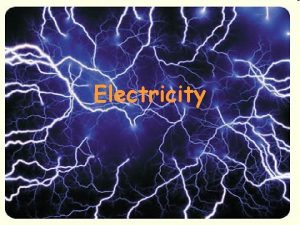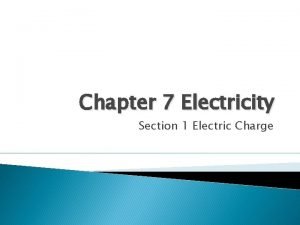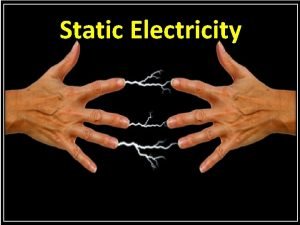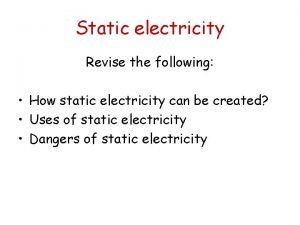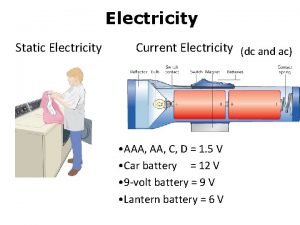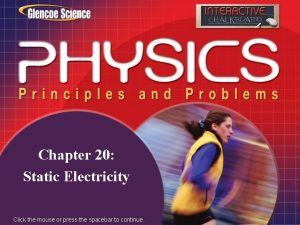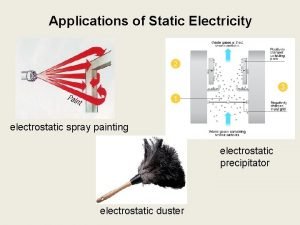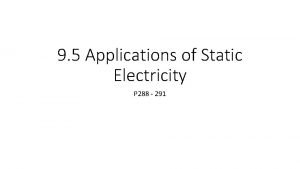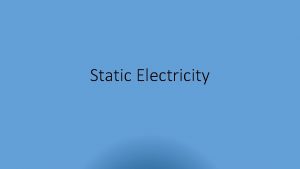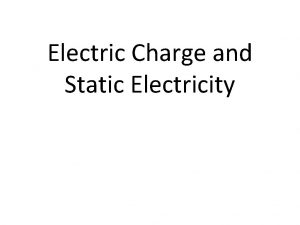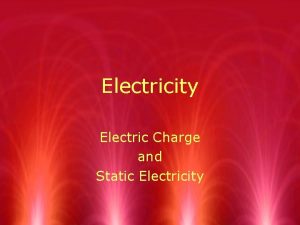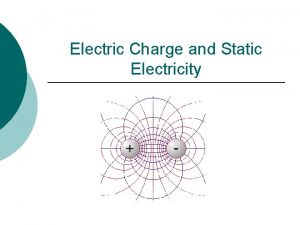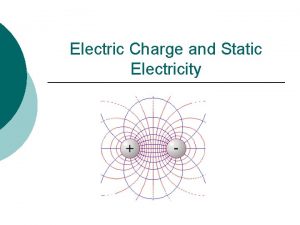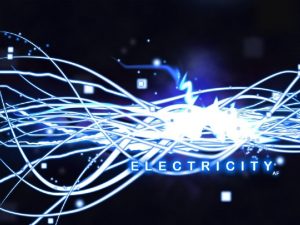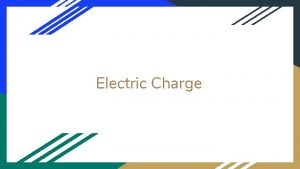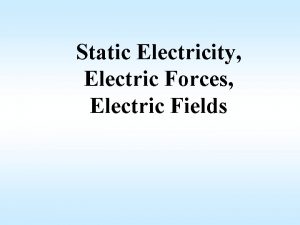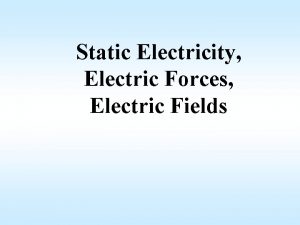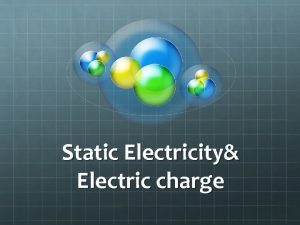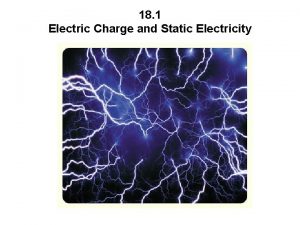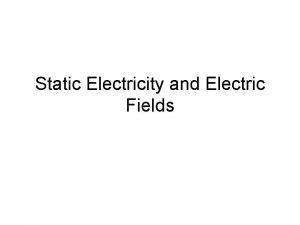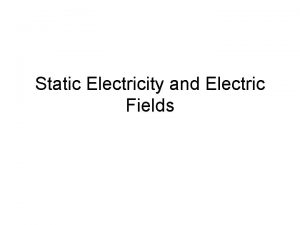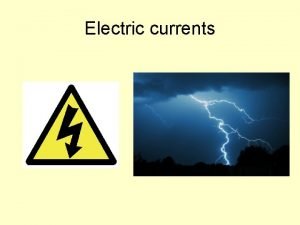Static Electricity Electric charge Electricity is a natural





















- Slides: 21

Static Electricity& Electric charge

Electricity is a natural phenonmena Observable in weather as lightning. When do we see lightning? https: //www. youtube. com/watch? v=k. Ygu. AFZwhp. U

Lightning notes What causes lightning? What causes thunder? https: //www. youtube. com/watch? v=h-0 g. Nl 5 f 4 BU

Lightning is Static Electricity…how does that work? Static electricity occurs when positive (+) or negative (−) electrical charges collect on an object's surface. There are several ways this condition can be caused. One way is by rubbing certain materials together or pulling them apart. Another way that static electricity commonly seen is when a charged material is brought near a neutral material. This is called electrostatic induction. You can also cause static electric separation of charges by using pressure in certain materials or using heat in other materials.

Questions you may have include: How does separating materials cause static electricity? What is electrostatic induction? How does pressure or heat cause static electricity?

Separating or rubbing materials When two different materials are brought into contact and then separated, some outer shell electron may be captured by the other material. This results in the atoms of one material having an excess of electrons and thus a negative (−) electrical charge and the other material missing electrons and having a positive (+) electrical charge. Rewrite the above paragraph in your own words. Electrons exchanged when objects pulled apart


Putting certain materials together and then pulling them apart or rubbing them together can cause excess electrical charges to be created on their surfaces.

Excess of charges Most matter is electrically neutral. That means its atoms and molecules have the same number of electrons as protons. Periodic Table of Elements – Every kind of atom we know of. Atoms are arranged by how many protons (+) they have.

Excess of charges If a material somehow obtains extra electrons and attaches them to the atom's outer shells, that material has a negative (−) charge. Likewise, if a material loses electrons, it has an excess of positive (+) charges. The electric field from the excess of charges then causes the static electric effects of attraction, repulsion or a spark.

Explain the drawing to your neighbor.

An ion is an atom that has a net charge because it has gained or lost electrons. A cation is a positively charged ion. Total charge is + An anion is a negatively charged ion. Total charge is Anion (-4 was -5) Will become an: Anion (-1)

Adhesive force takes electrons A force called the adhesive molecular force holds materials together. But when two different materials are pressed together and then pulled apart, the adhesive molecular force pulls electrons from one material and deposits unto the other. This creates the separation of charges or static electricity. Although your can create static electricity by pressing materials together and pulling them apart, rubbing them together usually works even better.

Materials: Certain combination of materials work better than others in creating static electricity. The Triboelectric Series lists materials according to how likely they are to let go of electrons or to take on electrons from other materials.

The Triboelectric Series Dry human skin and rabbit fur have the greatest tendency to give up electrons when rubbed on something and become positively (+) charged. Teflon and vinyl have the greatest tendency to become negatively charged (−) when rubbed. Rubbing a balloon on a wool sweater creates static electric charges on the surfaces

Electrostatic induction Charged plastic rod induces charges in metal plate When you bring an object with static electricity charges on its surface near another object, those charges will induce opposite charges to come to the surface. This works best with conductors, which allows charged particles to move around fairly freely, but also works with nonconductors to a lesser degree.

Electrostatic induction The electroscope—a device used to detect static electricity—uses this principle to charge its detecting parts. Induction also explains how a charged balloon can be made to stick to the wall.

Special pressure and heating causes Pressure or mechanical stress and heat can cause electrical charges to separate and create a static electricity situation.

Piezoelectric effect When pressure or stress is applied to certain crystals, opposite electric charges collect on the ends of the crystal. By maintaining the pressure on the crystal, the static electric effects can be demonstrated. Piezoelectric effect creates charges near surfaces Although applying pressure to a piezoelectric crystal is considered causing static electricity, its use is in creating an electrical current for numerous applications. (microphones)

Pyroelectric effect When heat is applied to certain materials, positive and negative charges move to opposite ends of the material. By maintaining the heat on the material, the static electric effects can be demonstrated. Pyroelectric effect creates charges near surfaces Although the separation of charges is considered static electricity, the usual applications of the pyroelectric effect is to create electric current for various devices. (touchscreens)

Summary by Bill Nye http: //www. dailymotion. com/video/xlp 2 y 9_bill-nyestatic-electricity_tech
 Static electricity and current electricity
Static electricity and current electricity Current electricity
Current electricity Electricity and magnetism vocabulary
Electricity and magnetism vocabulary Chapter 6 section 1 electric charge worksheet answers
Chapter 6 section 1 electric charge worksheet answers Section 1 electric charge crossword puzzle answers
Section 1 electric charge crossword puzzle answers Electricity section 1 electric charge
Electricity section 1 electric charge Difference between charge and electric charge
Difference between charge and electric charge Difference between charge and electric charge
Difference between charge and electric charge Chapter 21 electric charge and electric field
Chapter 21 electric charge and electric field Chapter 21 electric charge and electric field
Chapter 21 electric charge and electric field Coloumb units
Coloumb units Units of a charge
Units of a charge The buildup of electric charges on an object
The buildup of electric charges on an object Photocopier static electricity
Photocopier static electricity Bill nye series and parallel circuits
Bill nye series and parallel circuits What is electricity
What is electricity Ampere unit
Ampere unit Chapter 20 static electricity answers
Chapter 20 static electricity answers Electrostatic spray painting physics
Electrostatic spray painting physics Static electricity painting
Static electricity painting Static electricity.
Static electricity. Static electricity examples
Static electricity examples




